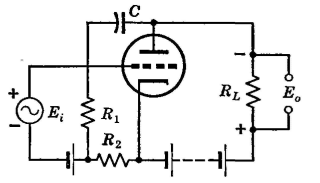| Electrical Communication is a free textbook on the basics of communication technology. See the editorial for more information.... |

|

Home  Electronic Applications in Communication Electronic Applications in Communication  Neutralization Neutralization |
|||||||






|
|||||||
NeutralizationTriodes are often used in radio as power amplifiers, oscillators, and frequency multipliers. At these frequencies there is considerable signal fed back from the plate circuit, through the grid-plate interelectrode capacitance, and into the grid circuit; this may cause positive feedback and undesired oscillations. Neutralization must be used, particularly with triodes, to prevent such oscillations. Several neutralizing circuits have been developed.21 One method is to connect an inductor and a capacitor in scries between the plate and grid. The capacitor is necessary because the plate and grid are at different direct voltages. This series combination is sufficiently inductive so that it feeds back enough lagging current to neutralize the leading current that flows back through the grid-plate capacitance. Another viewpoint is that the series inductor-capacitor combination in parallel with the interelectrode capacitance causes the impedance between plate and grid to be very high, and hence the net current fed back is very low. A neutralizing circuit that is highly recommended21 is shown in Fig. 29. The circuit L-C1 is adjusted so that it is inductive and a
lagging current flows through C1. This causes a drop across C1 that lags the current by 90°. Hence, a voltage exists across C1 that is 180° out of phase with the plate-to-cathode voltage. When the neutralizing condenser CN is properly adjusted, as much 180° out-of-phase current will be fed back through it as is fed through Cgp, and in this way neutralization is accomplished. Capacitor C2 is adjusted-to parallel resonance with the L-C1 combination, and hence this parallel combination causes little effect between the points connected. When tubes are used in push-pull, neutralization is simple. Because the two plate-to-cathode voltages are 180° out of phase, it is only necessary to connect a suitable variable capacitor from the plate of each tube to the grid of the other. The neutralizing circuits may be adjusted in several ways. One method is to have the circuit in operation, except that the direct plate voltage is not applied. Then the neutralizing circuit is adjusted so that, with a signal applied to the grid circuit, only a very small signal (as determined with a wavemeter) is produced in the plate circuit. The wavemeter is an instrument composed of an adjustable capacitor, an inductor, and a thermogalvanometer in series.
|
|||||||
Home  Electronic Applications in Communication Electronic Applications in Communication  Neutralization Neutralization |
|||||||
Last Update: 2011-05-30




